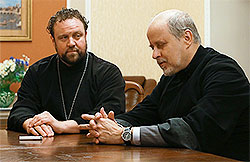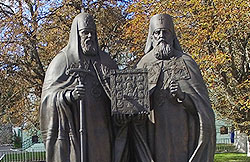Delegates speak about the pilgrimage of the Kursk Root Icon of the Mother of God "of the Sign” to Kursk in 2018
 Protopriest Seraphim Chemodakov of St Alexander Nevsky Cathedral in Lakewood, NJ, member of the delegation of the Russian Orthodox Church Outside of Russia which brought the Kursk Root Icon of the Mother of God "of the Sign" to Russia. Protopriest Seraphim Chemodakov of St Alexander Nevsky Cathedral in Lakewood, NJ, member of the delegation of the Russian Orthodox Church Outside of Russia which brought the Kursk Root Icon of the Mother of God "of the Sign" to Russia.
-Fr Seraphim, what were your impressions of the trip to Russia?
This is the first time I accompanied the miracle-working icon and was astounded when I saw such all-encompassing love for the image. In America, the people are too busy to greet the icon in the way it was greeted here, because there has been a modicum of cooling to the faith because of the demands of daily life. Here, thousands of people are ready to stand in line for hours at a time for the opportunity to venerate the miraculous icon. In addition to the masses, I was amazed at the age groups: there were many in their senior years with walking sticks. But so many young people came, young couples with their children! During my shift watching the icon, I saw the eyes of the people; there were no disinterested people or blank expressions. I discerned faith, hope in the Mother of God, the Deliverer from Sorrows, and love for Her. It was unforgettable.
-The head of your delegation, Bishop Nicholas of Manhattan, said the same thing. What was most memorable at the Kursk-Root Hermitage?
A great deal. The beautiful cathedral, the orderly monastic services, the immaculate grounds, the goodwill of the brethren and laborers, the many pilgrims. I had a favorite moment: I was walking down towards the cathedral, turned a bit to the right and see a monument, painfully familiar. I knew that there are three monuments in the world erected to our great contemporaries thanks to whom the division within the Russian Orthodox Church was overcome, the division that began during the Revolution and Civil War. These were His Holiness Patriarch Alexy II of Moscow and All Russia and Metropolitan Laurus of Eastern America and New York of blessed memory. I had know about it, but forgot. Suddenly I saw it and was thrilled. One of these monuments is at St Alexander Nevsky Cathedral in Howell, NJ. The base contains the inscription: “This is a Gift to the Russian Diaspora from the People of Orthodox Russia.”
At the Kursk-Root Hermitage, according to its Prior, Fr Serafim, the monument was erected a few months earlier, in October 2015. The third of the series, called “Reunification” and dedicated to the signing of the Act of Canonical Communion between the Russian Orthodox Church and the Russian Orthodox Church Outside of Russia, was erected near Christ the Savior Cathedral in Moscow last summer.
I’d like to share another joyful moment; Fr Paul Wolkow, a member of our delegation, and I descended the long staircase to the holy wellsprings, where we immersed ourselves, and I had a thought: Prokhor Moshnin once lived and prayed here—the future St Seraphim of Sarov! At the age of ten he was miraculously healed from this miracle-working icon which we just brought from America. My parents named me, their eldest son, in honor of Batushka Seraphim, and in those moments I clearly sensed his presence next to me. In an instant, all the events of recent days blended into one.
 Protodeacon Paul Wolkow of St Seraphim Church in Sea Cliff, NY, which in 2012 became the Memorial Church of the Reestablishment of Unity of the Russian Orthodox Church. Protodeacon Paul Wolkow of St Seraphim Church in Sea Cliff, NY, which in 2012 became the Memorial Church of the Reestablishment of Unity of the Russian Orthodox Church.
-Reverend Protodeacon, what can you add to Fr Seraphim’s memories?
First of all, let me tell you a bit about our life in America. Our parents who arrived there in the 1950’s reared us to be proud to be Russian. Fr Seraphim’s father has been a clergyman at an Orthodox parish in Australia for over 40 years. Fr Seraphim’s uncle is Archbishop Gabriel of Montreal and Canada. On my mother’s side there were many eminent protopriests and protodeacons who were imprisoned in the Soviet Union. I say this in order to demonstrate that our parents taught us adherence to the Orthodox faith, love for our historic Homeland and the rich Russian tongue. They gave us a great deal. We took the baton, as it were, and try to pass it on to our children and grandchildren, but of course is not easy these days. But let’s imagine how hard it was for our emigres living abroad, where every Russian was seen as a communist! Still, the faith which always bound together our people, helped the refugees endure. Wherever Russians settled, they opened churches, Russian schools. From the history of our own St Seraphim Church I know that in the 1950’s, ten families raised a thousand dollars (that was a lot for emigre refugees), and bought a parcel of land. The priest at the time was 92 years old: Fr Daniel Dumsky, who was born in Russia under Emperor Alexander II. He died at 102… In order to build a church on that parcel, the parishioners visited garbage dumps looked for boards, nails, other building materials. They lived with the spirit of their pre-Revolutionary Homeland, and I think that their prayers were stronger than those of succeeding generations.
And it was important that this Orthodox faith not be interrupted, that it set deep roots in the distant continent.
The trip to Russia with the icon has left an indelible impression in my soul, which I will share with my parishioners.
Nina Stavitskaya
|